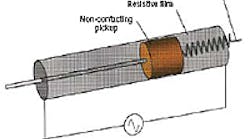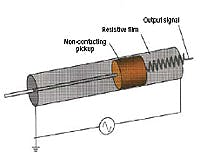Resistitive sensors avoid all contact
Resistive sensors have always been a simple and economical means of producing an electrical signal analogous to position. However, resistive sensors (potentiometers, or pots) have always suffered from the limitation that a moving element (wiper) must be in physical contact with a stationary one (resistor). This is especially true when using pots for position feedback in fluid power cylinders.
The physical contact produces wear, so pots must carry a maximum life under ideal conditions. Speed has also been a limiting factor because excessive speed can cause a loss of contact between the moving wiper and stationary resistor. Furthermore, the contact area becoming corroded or otherwise contaminated can produce signal discontinuities or complete loss.
Some of these detrimental effects have been reduced somewhat by newer technologies — such as conductive plastics. However, the need for physical contact still poses serious limitations for using pots in most industrial applications. Therefore, non-contact sensors have found favor with most designers of industrial equipment. Even though they carry a higher inital cost, contactless sensors are more costeffective because they have an infinite theoretical life.
No more contact
A new development in resistive sensing technology does away with the contact between a “wiper” and resistor. Instead, the Capacitively Coupled Resistance Sensor (CCRS) uses the property of capacitance to transmit a position signal from a resistor to a non-contacting pickup. Developed by Sentrinsic, Atlanta, the CCRS does not measure capacitance, so it is not subject to the limitations of capacitance, such as temperature sensitivity, nonlinearity, etc. It measures position through resistance, so it retains the advantages of resistance sensing without the limitations inherent to conventional technology.
For application in a cylinder, a layer of resistive film is embedded within a composite cylinder barrel or lowfriction liner inside a metal barrel, and a non-contacting pickup is located in the piston. An AC voltage is applied to the film, so as the cylinder’s piston rod extends or retracts, the resistance increases or decreases accordingly and corresponds to piston position.


